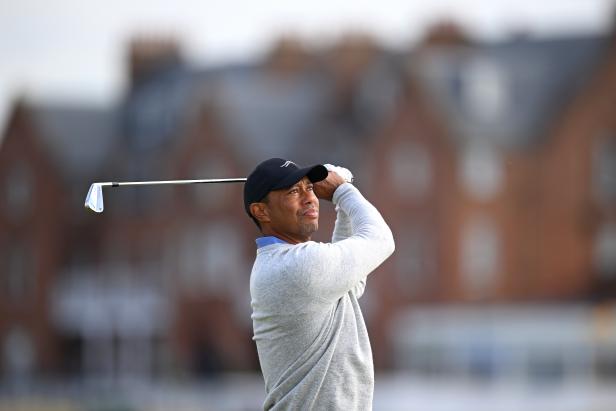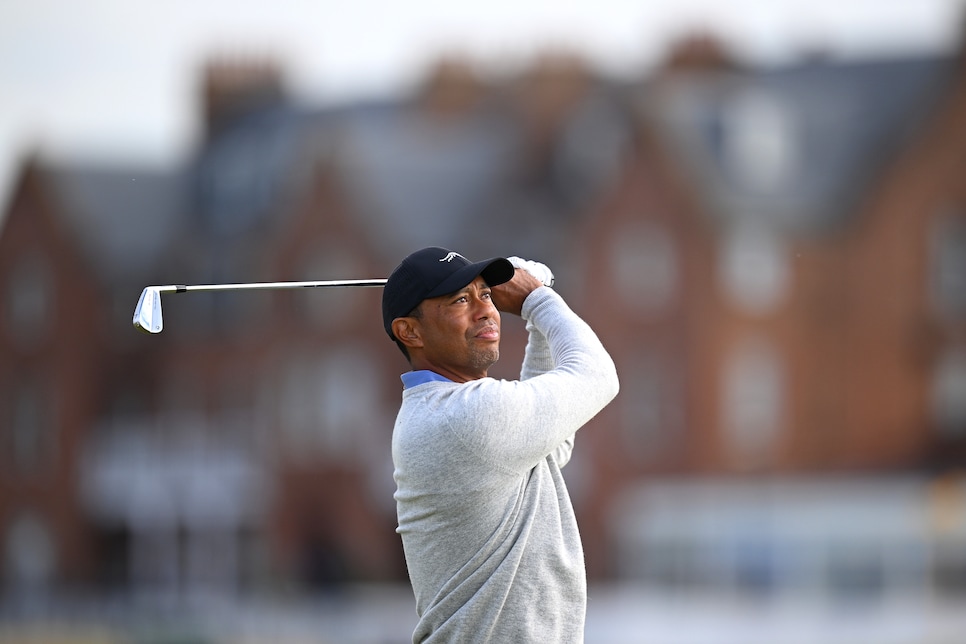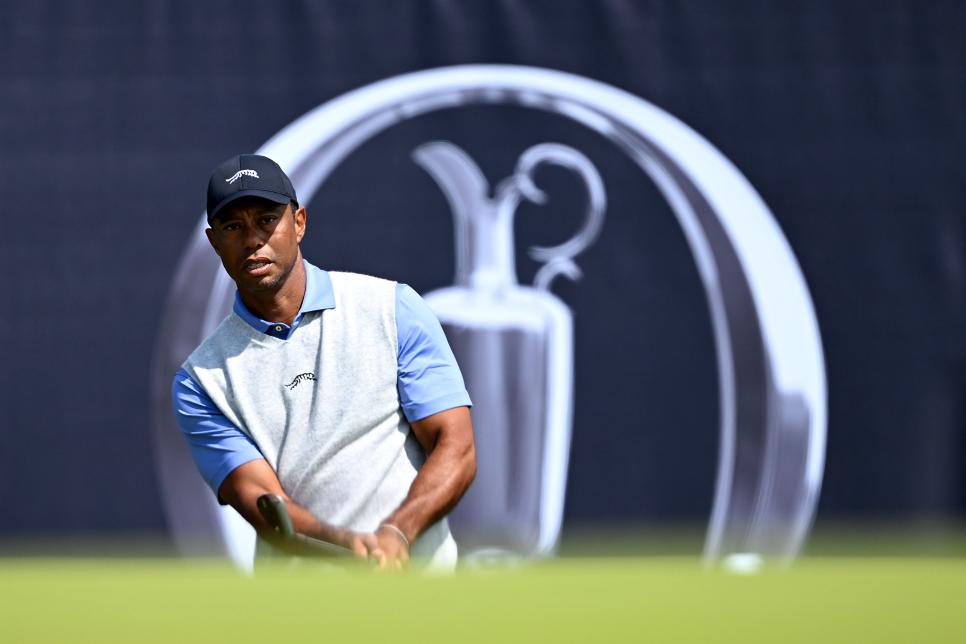OPINION: Tiger Woods fired back at Colin Montgomerie, but Monty knows the truth – Australian Golf Digest

- by Admin
- July 16, 2024

Only a chosen few are awarded “The Stop.” It is both earned and conferred, and always cashed in at the Swilcan Bridge. The legend makes his way over the crossing, pauses, perches his leg up on the stone ledge, turns away from the Old Course and toward the fans to his right and behind him, then back to the town of St Andrews and to the people craning their necks from pubs and hotel windows to say they saw it, and waves. The Stops of yesteryear are run annually on Open broadcasts and pictures of The Stop are plastered in clubhouses across the world, because The Stop matters, a graceful transition of a golf legend from the pangs of now into the gloss of the past.
Tiger Woods was bestowed The Stop in 2022. It made sense; he was nine over through 35 holes, 20-something shots behind the leader and miles from the cut. He was just 46 years old, but his return from a savage car accident raised plenty of questions about an already tenuous future, and with the R&A likely deviating from its tradition of hosting the Open at the St. Andrews every five years it was unclear when the Auld Gray Toon would host again … and what type of shape Woods would be in when that time came.
Woods is a student and historian. He is well aware of The Stop. What it means, to himself and to others. Over the past decade, he had preached a cognisance of the finish line. And yet, knowing what was ahead, Woods glided over the most famous bridge in golf, stride unbroken. He did raise his hat to the heavens, a concession made by his brain, but his legs were taking direction from his heart. At the 150th Open, Tiger Woods was given The Stop. He kept walking.
David Cannon
• • •
“I hope people remember Tiger as Tiger was, the passion and the charismatic aura around him,” Colin Montgomerie said in an interview with The Times of London last week. “There is none of that now. At Pinehurst [for the US Open], he did not seem to enjoy a single shot and you think, ‘What the hell is he doing?’ He’s coming to Troon, and he won’t enjoy it there either.” Montgomerie later added, in response to Woods’ comments last month that his competitive days may be numbered, “Aren’t we there? I’d have thought we were past there. There is a time for all sportsmen to say goodbye, but it’s very difficult to tell Tiger it’s time to go. Obviously, he still feels he can win. We are more realistic.”
On Tuesday at Troon, Woods fired back when a reporter asked about the Scot’s comments.
“Well, as a past champion, I’m exempt,” Woods said. “Colin’s not. He’s not a past champion, so he’s not exempt. So he doesn’t get the opportunity to make that decision. I do.” When pressed further if he’s earned the privilege to continue, Woods responded, “When I get to his age, I get to still make that decision, where he doesn’t.”
To various extents for the last decade, similar eulogies have been made about Woods’ career—only for Woods to prove how much life he has left. Perhaps that’s partly why Monty’s remarks made the rounds. But as blunt as Montgomerie was, the collective response has been just as telling, because there has been little, if any, rebuttal. Montgomerie said what we all know to be true:
In sports, everything ends badly. Otherwise, it wouldn’t end.
Badly is a sober assessment of Woods’ golf as of late. More than as of late: Since winning the 2019 Masters he has failed to finish inside the top 20 at a major and has either missed the cut or withdrawn in five of the last seven. He’s played four rounds of an official tournament just three times in the last four seasons. This is partly an upshot of the fact he hardly plays at all. The last time Woods teed it up at an event that wasn’t a) a major, b) his Genesis Invitational or c) a silly-season event was in the summer of 2020. That is the profile of a ceremonial figure … which Woods was at the US Open, in the field thanks to a special exemption from the USGA. He fought, but Pinehurst painfully illustrated it was a test he could not pass. Golf pounds its chest about its meritocratic fields but Woods, in his current form, is more celebrity than competitor.
In itself, this is not a surprise. Willie Mays is often cited as the star who remained too long after he stopped emitting light. The truth is Mays is the rule, not the exception. Tom Brady could’ve walked away after winning a Super Bowl in his first season away from New England; he stayed for two more years, his last the first losing-season in his 21-year career as a starter. Michael Jordan’s second comeback was better than it’s remembered, but Jordan missed the playoffs in both of his years with the Washington Wizards (after winning the NBA Finals his final three years with the Chicago Bulls) for calling it quits for a third and final time. Muhammad Ali was so sluggish in a return bid against Larry Holmes that the fight was described as “watching an autopsy on a man who is still alive.” Jerry Rice, Shaquille O’Neal, Greg Maddux, Brett Favre, Chuck Liddell … the very drive that makes the greats great often blinds them from seeing the petrol light furiously flashing on the dashboard, their engines needing to go up in smoke before conceding the tank is well past empty.
Golf is a different bird. There are no front offices making cuts or governing bodies ruling an athlete unfit for competition. Woods can play the Masters and PGA Championship as long as he wants and last month was gifted a lifetime exemption into PGA Tour signature events. The Open only recently implemented an age restriction at 55 years old, although Woods is grandfathered into the previous limit of 60. There’s also the golden parachute that is the senior tour. Golfers don’t retire, they fade into competitive irrelevance as the next generation emerges.

Stuart Franklin/R&A
The problem is Woods continues to be the sun this solar system revolves around, and why the finality of Woods’ career is something of a third rail. Fans don’t want it to be true, and collectively, no one quite understands what the end looks like, including Woods.
That is at the heart of what Montgomerie was trying to convey. Woods has asserted he only tees it up when he thinks he can win. He doubled-down on the sentiment Tuesday at Royal Troon. “I’ll play as long as I can play and I feel like I can still win the event,” Woods said, the implication being that he feels that way about his chances this week in Scotland.
The thing is, what Woods wants to do—what fans want him to do—he physically can’t, his impressive physique belying a body fused together through more surgeries than you can count on two hands. And though the runway for those on the backend of their careers has been extended thanks to equipment gains and advancements in sports sciences such as training and recovery, professional golf is unequivocally a young man’s game. Rory McIlroy is the only player older than 30 inside the world’s top 10, and Adam Scott is the lone player older than 40 in the top 60.
Of course, this is ultimately Woods’ legacy and his life, and Woods was clear Tuesday that he would not take directions from anyone but himself

Stuart Kerr/R&A
Woods has earned the right to choose when he’ll step away. And the case can be made that there’s something noble in battling a destiny we cannot escape yet refusing to surrender all the same. That he can conjure the magic that Phil Mickelson did at Kiawah, that 59-year-old Tom Watson did at Turnberry. The hope that, if only for one week or even one day, Woods can be as good as he once was.
Conversely, for all the romanticism of the Open, it is a major championship and major championship golf is cannibalistic. Montgomerie was blunt but the underlying heart of the message was one of compassion. He’s trying to tell Woods what he apparently can’t see, and what Montgomerie doesn’t want to see again.
• • •
In an exceedingly paint-by-numbers game, links golf requests—maybe the best phrase is requires—one to draw outside the lines. Precision and power take a backseat to vision, artistry and feel. Experience matters here more than any other major setting. The Open is also infamous for occasionally slimming its field in half depending on the weather. It’s not hard to squint and see a scenario in which Woods is hanging around come Friday evening.
Woods does look healthier and slimmer in Scotland. He says he’s been “training a lot better” and “busting it” in the gym. “I’m able to do some things that I haven’t done all year, which is nice.” He arrived at Royal Troon on Sunday and walked 18 holes, acquitting himself with a course he hadn’t played competitively in two decades. He played another nine on Monday. He’s getting through the ball well, the distance is OK and the ball-striking remains world class. When things are going good, he looks and sounds and feels like the eternal Tiger Woods.
Except, it’s not about the golf, because in between his shots on the course and range Woods has been noticeably hobbling. (During his press conference, he wore shorts and a compression sleeve on his right leg from above the knee to his foot.) It is a gait hampered by injuries, functional only through an unshakable will and the belief that he can keep going because he’s done it countless times before. However, there is no thing such as eternity in sports. Eventually, everything has to stop.
The Latest News
-
November 15, 2024List wins elusive DP World Tour card, Barron loses his
-
November 15, 2024India great warns ‘the king is back in his territory’ as struggling Virat Kohli returns for fifth tour
-
November 15, 2024Nick Kyrgios: Australian tennis star confirms return to ATP Tour at Brisbane International in December
-
November 15, 2024Lucas Herbert grabs NSW Open lead from Cam Smith, sets up thrilling weekend at Murray Downs – Australian Golf Digest
-
November 15, 2024Kohli under cloud as Indian skipper remains in limbo





